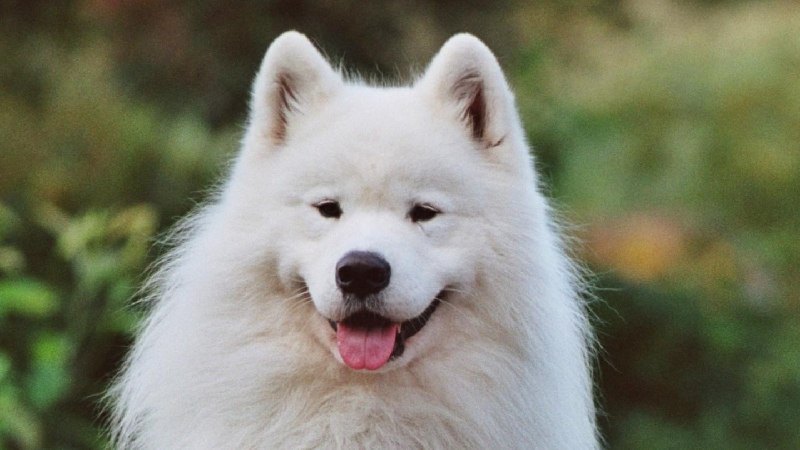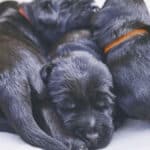The Evolution of the Samoyed
The years around 3000 BC were a time of development for world civilizations. The Iceman, Europe’s oldest natural Chaliolithic mummy, lived during this period; Egypt had its first Pharaoh; the wheel was invented; and the Druids had begun the construction of Stonehenge, which would not be completed for another 1,500 years. Up on the remote Russian tundra, however, a new discovery was unearthed in 2004, dating back to that same time period in history: the remains of the oldest proto-Samoyed!
The Samoyed was originally thought to be an aboriginal breed that was indigenous to the Russian tundra. It is now thought, due to modern DNA testing, that the earliest proto-Samoyed may have migrated into Russia from China. USA Today reported in 2004 that researchers had announced surprising news regarding which breeds of dog came first. By analyzing genetic data from 85 breeds, researchers discovered that Asian Spitz-type breeds may be the most ancient descendants of its primitive wolf ancestors from 40,000 years ago.
It was once thought that all dogs originated in Asia, migrating with nomadic hunters to Africa and the Arctic. It is now thought that dogs originated from civilizations around the world at different times. A subset of the oldest group that is thought to come from Asia are the three Northern breeds: Alaskan Malamutes, Samoyeds and Siberian Huskies. All three breeds have the closest genetic relationship to the ancient, now extinct wolf. According to researchers, these three breeds may be “the best living representatives of the ancestral dog gene pool.” This is due to thousands of years of isolation in remote arctic locations.
The theory is that proto-dogs were probably domesticated by accident, when wolves began trailing ancient hunter-gatherers to snack on their garbage. The more docile wolves may have been slipped extra food scraps… so they survived better and passed along their genes. Eventually, those friendlier wolves evolved into proto-dogs.
It is thought (because there were no written records) that the proto-Samoyed most likely followed nomadic hunters migrating from Asia to the Russian tundra. There the hunters found an abundance of reindeer, switched to reindeer herding, and began migrating with the herds around the tundra. The proto-Samoyeds continued to follow the humans and the herd. This became a lifestyle for these aboriginal people who later became known as the “Reindeer People.” The region of Russia where the Reindeer lived was in a location where winter began in September and lasted until the end of May.
The herd would migrate in a 700-800 mile migration pattern in search of food. The reindeer were independent creatures, and it required very vigilant and alert dogs to keep the large herd intact! The early proto-Samoyed dogs, known as “Laikas,” which is Russian for “barkers,” had to quickly adapt and learn to co-exist closely not only with the humans, but also with the herd in order to survive the brutal arctic conditions. Co-existing allowed these early dogs access to warmth, shelter and food in exchange for the dogs’ protection and assistance with keeping the herd together. Man and dog were co-dependent on each other for survival in a frozen land where death seemed easy and survival difficult during the long winter months. The average lifespan for the “Reindeer People” was around 45 years.
Highly intelligent, the Samoyed became an independent, free-thinking breed that worked primarily off-lead in wide-open territories, unlike the other Northern breeds that worked primarily in harness. The largest tribe of reindeer herders was the Nenet tribe, who referred to themselves as “Children of the Reindeer” and had a close relationship with their dogs. Family members would take the dogs into the tents they lived in, called chooms.
Each choom was covered in 100 reindeer hides or in tree bark. There was a fire pit in the center of the choom for cooking and warmth, and the Nenets allowed the dogs to sleep with them at night to provide extra warmth. Dogs were stationed outside the tents to keep the deer herd away from the chooms, and a second group of dogs was stationed around the circumference of the herd to keep the herd intact, and to “sound the alarm” in the event of approaching danger.
The Nenets also used the dogs for light freighting, such as to carry them out to the fishing holes on the ice to retrieve fish from the fishing lines, (the ice was too slippery for deer hooves) and, in addition, the dogs were used to hunt, including hunting the polar bear. The Samoyed ultimately became a multi-purpose dog that had to fill a number of jobs within the family circle. Over thousands of years, the Samoyed was gradually changed by its environment and by evolution into the natural breed that we know today.
Now we will fast forward 4,800 years to the late nineteenth century! During the late 1800s, the Samoyed first became known to the outside world due to the exploration of the North and South Poles. Most of the Samoyed strains in the UK and in the United States are related to the veteran sled dogs of these expeditions. When the men returned to their homelands, many brought the dogs with them. It is speculated that there were only twelve dogs that constituted the original breeding stock outside of Russia!
The first Samoyed brought into England in 1889 by Mr. Kilburn Scott was a brown Samoyed male named Sabarka that was put on display at the London Zoo. Sabarka was quite the novelty and drew many visitors to the zoo, generating interest in the breed! His wife, Mrs. Clara Kilburn Scott, was very taken with this newly discovered breed, and was very instrumental in establishing the breed in England through her selective breeding of Samoyeds.
It was Mrs. Kilburn Scott who decided to breed only for the white, crème and biscuit colored dogs, eliminating the black, brown and spotted colors from the breeding stock. The first official standard for the breed was adopted in England in 1909, and the first American standard was adopted on May 15, 1923.
As breeders, we delight in seeing remnants of the Samoyed’s ancient ancestry in our litters, with the biscuit coloring being a throwback to the brown Samoyeds of the past. AKC has stated that judging conformation should be for the evaluation of breeding stock. That being said, the following is this breeder’s perspective on evaluating the Samoyed, based on preserving its long and ancient heritage.
General Appearance
“The Samoyed should present a picture of beauty, alertness and strength, with agility, dignity and grace.” As the judge stands back and takes a first look at the lineup, the judge should be looking for a balanced animal. A balanced animal can set itself up four square without having its legs constantly reset. A balanced animal has bone that balances out its frame and is in proportion to its body size. The rear angulation and the front angulation should be in harmony with one another. The arch of the tail should balance out the arch of the neck.
The back of the animal should be medium in length and should be in proportion to its height…males should be just off-square, with bitches allowed to be slightly longer. The length of leg should be approximately 55% of the animal’s height for optimal functionality in the deep tundra snow…if there is any question about the length of leg, then the coat should be pushed back at the elbow to see where the elbow ends…the Samoyed is a double-coated breed, so you must put your hands on the dogs to find what is underneath, as coat can be deceptive.
While you are at it, check the texture of the coat….it should be weather resistant, and the quality of the coat should be considered more than quantity, as this is a survival characteristic for the Samoyed on the frigid Russian tundra.
The only acceptable colors for the breed are white (and there are many shades of white,) cream, biscuit or white & biscuit…any other color is a disqualifying fault. The coat should glisten with a silver sheen when the light hits it…this is caused by the silvertips on the ends of the coat, which is a beautiful and unique characteristic of our breed! The silvertips also help to repel and prevent snow from packing into the coat of dogs living on the tundra.
Do not expect this breed to stand in the lineup motionless like a Doberman or a Pointer…it is an active breed and is keenly aware of its surroundings! If a Samoyed hears an unusual noise, it will look to see what it is…sometimes insisting on facing in the opposite direction to get a better view! This is the nature of the breed…they are alert, independent dogs that are full of action…genetically programed over thousands of years to herd and guard the Nenets’ reindeer on the Russian tundra and to serve as an all-purpose dog and companion for the Nenet people.
The Judges Exam
Start the exam with the head. The ears should be thick, well-furred and mobile, which protects the ears from freezing on the tundra. The ears should be in proportion to the size of the head and the dog. If you think the ears look too long or too short, fold the tip of the ear towards the outside corner of the eye…the tip of the ear should end close to this point if it is the correct size. Ears should be set well apart, but positioned within the border of the outer edge of the head.
The head should form a wedge…it can be a narrow wedge or a wide wedge, depending on breeder preference, and the stop should not be too abrupt, which enhances the aerodynamics of the dog when moving, and also enhances the wedge shape of the head. The skull should be broad, but not round, and form an equilateral triangle between the inner base of the ears and the central point of the stop. Eyes should be dark for preference, placed well apart, and almond shaped with the lower lid slanting towards the outer corner of the ear.
This is a survival characteristic of the breed, and it is interesting to note that most creatures living on the tundra, both human and animal, have this almond shaped eye. Evolution has created this eye shape, as a round eye has been shown to cause snow blindness from the many months of exposure to the sun’s glare on the arctic snow. Please note that blue eyes are a disqualifying fault in this breed!
The muzzle must be of medium length, neither course nor snipy, and must have sufficient underjaw to give depth to the muzzle. This is a survival characteristic, as the muzzle must be of sufficient length and depth to warm the frigid arctic air before it reaches the lungs. The nose should be black for preference, but a brown, liver or Dudley nose is not to be penalized. The teeth should snugly overlap in a scissor bite. Please note: There is no disqualification or penalty for missing teeth in this breed, so it is not necessary to count teeth or to open the mouth to look at the top and bottom dentition when checking the bite!
The lips should be black for preference and should curve up at the corners in a Sammy smile, even when the mouth is closed. Expression should consist in a “lighting up of the face” when alert or intent on anything. Ears should be erect and alert, eyes should sparkle and mouth should form the Sammy smile! There should not be droopy flews at the corners of the mouth, as this would cause saliva to accumulate and freeze around the mouth on the tundra while the dog is working.
Torso and Front End
From the head, move around to the side of the dog to examine the torso and front end. The neck should be of good length, strong and well-muscled. The neck should blend into the shoulder and topline with a graceful arch, and any other neck should be depreciated. An arched neck is thicker at the base and has stronger neck ligaments, which offers more power for the dog’s shoulder blades and front assembly while the dog is working.
A ewe neck, for example, is positioned upright, perpendicular from the shoulder and lacks any indication of an arch. This type of neck has weaker neck ligaments and because of that weakness has less support for the shoulder blades and front leg muscles. While this type of neckline might appear flashy in the showring, it does not offer optimal functionality for a Working Dog.
The chest should be deep, with the ribs well-sprung from the spine and tapering at the sides to allow movement of the shoulders and freedom for the front legs. The chest should be heart-shaped and not barrel-shaped. Perfect depth of the chest should be at the point of the elbow and the deepest part of the chest should be behind the forelegs, which provides more heart and lung room for working on the tundra. As breeders, we also like to feel “elbow pockets,” which are slight indentions in the rib cage under the elbows that allow more freedom of movement for the front legs without causing the Samoyed to move out at the elbows.
The shoulders should be long and sloping with a layback of 45 degrees. Also check the upper arm, which should be approximately the same length as the shoulder blade. The withers separation, which indicates the lay-in of shoulder, should be 1–1 ½ inches wide, or two to three fingertips apart, depending on the width of your fingers. The lay-in of shoulder tends to influence how the dog will put its front feet on the ground when in motion, and generally a Samoyed whose shoulders are not laid-in towards the spinal column will not converge into a single track when moving. The shoulder angles and lay-in of shoulder contribute to the dog’s endurance while working in the large open spaces of the tundra.
Next, run your hand down the front chest, where you should be able to feel the prosternum. The legs should be parallel and straight to the pastern, and approximately 55 percent of the dog’s height at the withers. Length of leg is important when working in the deep tundra snow. You will need to push the hair back on the chest at the elbow to determine the true length of leg, since this is a double-coated breed. Pasterns should be strong, sturdy and flexible with some spring for proper let-down of feet. The pasterns are the “shock absorbers” of the dog when moving and contribute to its endurance when working.
The feet are the dog’s running gear and should be long and slightly flat…a hare foot with two elongated central toes. The foot should be slightly spread, but not splayed, with arched toes, thick and tough pads, and a protective growth of hair between the toes. Faults are feet that turn in or out, round or cat feet and splayed feet. You can check the thickness of the foot pad when you get to the rear assembly by picking up a rear foot…and while you are there, check the bone by feeling the circumference of the rear hock.
Loin and Back
The withers form the highest part of the back. Run your hand down the back from the withers to the loin to make sure it is level and not roached or dipped. The loin is the distance between the last rib and the pelvis, and should be strong, slightly arched, and neither long nor short-coupled. The croup must be full and slightly sloping to the tail root.
The tail should be loose and mobile and not tight over the back. This is an important survival characteristic on the tundra, as the Samoyed had to be able to curl up and bury its face and muzzle in its tail when asleep to warm its breath and prevent freezing. The Samoyed should carry its tail up and over its back or side when alert, and dropped when at rest. The tail should be profusely covered with long hair and the tailbone should terminate at approximately the point of the hock. If there is any question about the length of the tail, you can measure it by pulling it down to the hock…but as a courtesy to the exhibitor, make sure you put it back over the back when you are done. The judge should see the tail over the back once during the judging.
Rear Assembly
Upper thighs should be well-developed. Palpate the upper portion of the thigh behind the stifles to check the muscle mass. Stifles should be well bent… approximately 45 degrees to the ground. Hocks should be well-developed and set at approximately 30 percent of the hip height. Straight stifles are objectionable; double jointed hocks or cow hocks are a fault. Cow hocks should only be determined after a dog has had the opportunity to move. Once you have examined the dog, it is time to move it to confirm what you have felt with your hands!
Movement
The Samoyed should trot, not pace, and should move with a quick, well-timed side gait! The gait should be free, balanced and vigorous with good reach in the front and equally good driving power in the rear. The back, or topline, should remain strong, firm and level, without a lot of up and down motion. If there is more reach than drive, or more drive than reach when viewed from the side, then it is not a balanced animal. This affects endurance when working on an open tundra.
The Samoyed should single track on the down and back. Moving at a slow walk or trot, it will not single-track, but as speed increases, the legs gradually angle inward until the pads are finally falling on a line directly under the longitudinal center of the body. This results in an efficient, ground covering gait that can be maintained for hours.
If you move a single tracking dog through snow, it will leave one line of paw prints in the snow, instead of two. This is not to be confused with crossing over, which is a fault. If you do not come from a breed that single tracks, then you will need to familiarize yourself with this movement so that you can identify it when you see it in your ring.
Disposition
Intelligent, gentle, loyal, adaptable, alert, full of action, eager to serve, friendly, but conservative, not distrustful or shy, not overly aggressive. Unprovoked aggressiveness is to be severely penalized. Good temperament is imperative in this breed. Herding reindeer on the tundra required that the Samoyed be compatible working alongside other animals as well as alongside humans, and we strive as breeders to maintain this disposition in our breeding stock.
It takes a long time to learn to evaluate dogs and to train one’s hands on what to feel and where to find it. Practice going over the dogs in a methodical fashion until you can do this quickly, and develop a routine where you can examine each dog in the same manner every time. Develop an eye for balanced and efficient movement so that you can spot correct movement when you see it. Learn to evaluate breeding stock!
In conclusion, the Samoyed today is very much a family dog and a house dog, similar to its ancient ancestors that slept in the chooms at night with the Nenets on the Russian tundra. Sammies enjoy being part of the family activities! They are up for anything their owners want to do…pack hiking, going for a jog in the park, weight pull, agility, sledding, herding, dock diving, obedience, and even lure coursing! A Sammy is very versatile and family oriented, maintaining its ancient reputation as an all-purpose working and companion dog! We ask that you, as judges, help us protect the integrity of this very ancient and beautiful breed in your judging.








